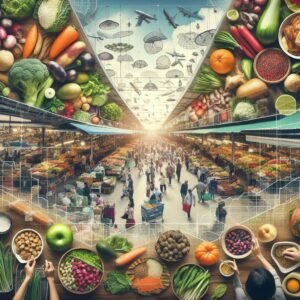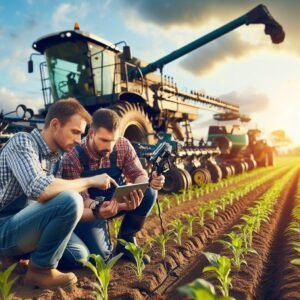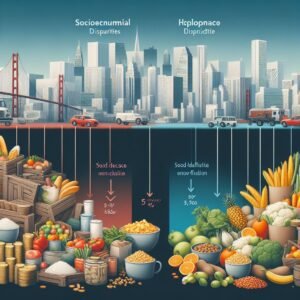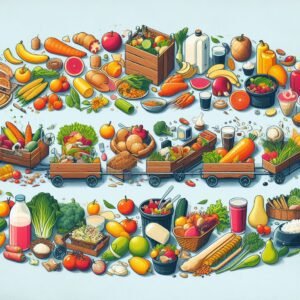Food is a fundamental necessity of existence, but its affordability and accessibility are increasingly turning into a subject for many individuals and households. In recent years, the value of food has been on the upward push, mainly due to questions about why meals come at a premium. In this newsletter, we delve into the various factors contributing to the escalating charges of food gadgets, losing light on the complex dynamics at play.
The importance of information on the underlying motives behind growing meal expenses can not be overstated. Not handiest does it impact customers’ budgets, but it additionally has ways-accomplishing implications for international meal safety, public fitness, and socioeconomic balance. By unraveling the intricacies of this trouble, we can better navigate the demanding situations and paint closer to sustainable solutions.
Factors Contributing to Rising Food Prices
1. Global Demand vs. Supply
The imbalance between global food demand and supply is a primary driver of rising food prices. With the world’s population steadily increasing, the demand for food has surged, placing immense pressure on agricultural systems to produce enough to feed everyone. However, this demand is not uniform across all regions or food types.
Key Points:
- The growing global population and changing dietary habits contribute to increased food demand.
- Limited agricultural resources, including arable land and water, constrain food production capabilities.
2. Climate Change
Climate change poses significant challenges to agricultural productivity, exacerbating the volatility of food prices. Extreme weather events such as droughts, floods, and heatwaves disrupt crop yields, leading to shortages and price spikes in affected regions. Moreover, shifting weather patterns alter traditional agricultural practices, requiring adaptation strategies to mitigate the impacts.

Key Points:
- Climate variability and unpredictability disrupt farming operations and reduce crop yields.
- Increased frequency and intensity of extreme weather events pose threats to food security.
3. Resource Scarcity
The scarcity of essential resources such as water and fertile soil poses significant obstacles to food production. In many regions, water scarcity restricts agricultural activities, necessitating the adoption of water-efficient farming techniques and irrigation practices. Soil degradation further diminishes land productivity, requiring investments in soil conservation and restoration efforts.
Key Points:
- Water scarcity affects crop irrigation and livestock rearing, impacting food production.
- Soil erosion, salinization, and depletion of nutrients degrade land quality and reduce agricultural output.
4. Transportation and Distribution Costs
The cost of transporting and distributing food from farms to consumers contributes to overall food prices. Factors such as fuel prices, transportation infrastructure, and logistical challenges influence the final retail price of food items. Remote and rural areas often face higher transportation costs, leading to disparities in food accessibility and affordability.
Key Points:
- Fluctuations in fuel prices affect transportation costs and, subsequently, food prices.
- Inefficient transportation systems and infrastructure gaps hinder the timely delivery of food to markets.
5. Market Speculation
Speculative activities in commodity markets can amplify food price volatility, making prices more susceptible to fluctuations. Investors and traders engage in buying and selling agricultural commodities based on anticipated price movements, which can artificially inflate or deflate food prices. Moreover, market speculation may disconnect food prices from underlying supply and demand fundamentals, leading to price distortions.

Key Points:
- Speculative trading in futures and options contracts affects food price dynamics.
- Price speculation can exacerbate food insecurity and hinder efforts to stabilize markets.
Technological Innovations and Food Prices
Technological advancements play a crucial role in shaping the landscape of food production and pricing. From precision agriculture techniques to genetic engineering, innovations in technology have the potential to revolutionize how food is grown, harvested, and distributed. In this section, we explore the impact of technological innovations on food prices and the broader implications for agricultural sustainability.

1. Role of Technology in Agriculture
Technology has transformed modern agriculture, enabling farmers to increase efficiency, productivity, and sustainability. Precision farming techniques, such as GPS-guided machinery and sensor-based monitoring systems, allow farmers to optimize resource use and minimize waste. Furthermore, advancements in biotechnology, including genetically modified organisms (GMOs), have led to the development of crops with enhanced traits such as pest resistance and drought tolerance.

Key Points:
- Precision farming technologies enable targeted application of inputs, reducing costs and environmental impact.
- Genetic engineering techniques contribute to the development of high-yielding and resilient crop varieties.
2. Impact on Production Costs
While technological innovations offer numerous benefits to farmers, they also entail upfront investment costs. Implementing precision farming technologies and adopting GMOs may require significant financial resources, particularly for small-scale producers. However, over time, these investments can lead to cost savings and improved profitability by enhancing crop yields and reducing input usage.
Key Points:
- Initial adoption costs of technology may be prohibitive for some farmers, limiting widespread adoption.
- Long-term benefits of technology adoption include increased productivity and resilience to environmental challenges.

3. Sustainability Considerations
The adoption of technology in agriculture raises important sustainability considerations regarding environmental impact and ethical concerns. While some argue that GMOs and intensive farming practices contribute to environmental degradation and biodiversity loss, others contend that these technologies are essential for meeting the food demands of a growing population. Balancing the benefits of technology with sustainability goals requires careful consideration of trade-offs and the implementation of policies that promote responsible innovation.

Key Points:
- Sustainable agriculture practices aim to minimize environmental harm while maximizing food production.
- Technology can play a role in achieving sustainability objectives through resource-efficient farming methods.















